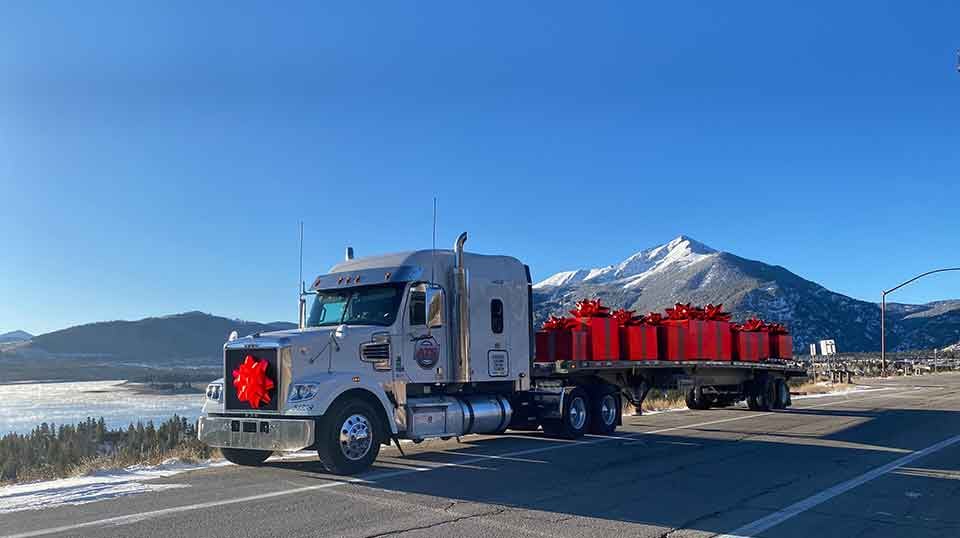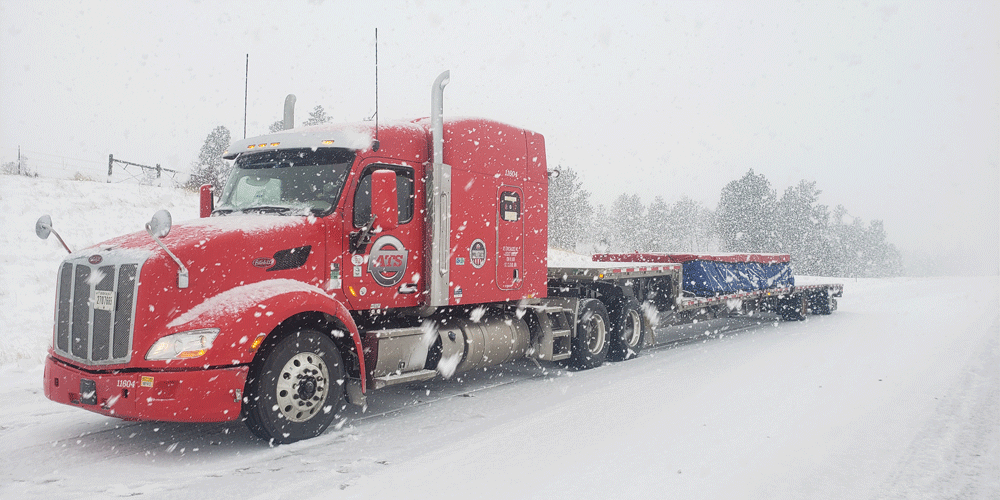
December has a certain reputation. Some know it as the jolliest month of the year. Some even look forward to the long nights and cold weather (hey, to each their own). But above all, December is known for being busy.
The trucking industry is no different. All those jolly holidays mean gifts, decor and treats are flying off store shelves. Long nights call for heating equipment, light bulbs and fuzzy socks. And the increase in gatherings means everyone needs more time — and that includes drivers.
But before the 2023 calendar goes to the recycling bin, let’s focus on the last month of the year and how it affects your shipments. At Anderson Trucking Service (ATS), we’ve been in the trucking industry for nearly 70 years. That’s a lot of Decembers, and a lot of lessons learned.
Read this article to learn what’s impacting the trucking industry right now, including:
- How the ongoing Panama Canal drought may impact the supply chain
- Dry van freight predictions for this month and beyond
- What’s in reefer trucks in December
- An update on open-deck freight
- Over-dimensional freight predictions for December
- How to plan for holiday shipping success
With this information, you’ll be ready to “sleigh” your shipping goals for the end of the year and set yourself up for a successful 2024.
Check Out December's Market Update Podcast 👇
Update: Low Levels in the Panama Canal
Drought continues to impact the Panama Canal, and low water levels mean that the number of vessels allowed through the canal is being reduced each week.
In the U.S., this means mostly that vessels are arriving at West Coast ports instead of East Coast ports. This may mean open-deck vehicles are more willing to travel west, where they are likely to find their next load.
While we aren’t yet seeing supply chain interruptions due to the Panama Canal situation, it’s worth continuing to monitor what’s happening. Many of the retail goods we use in this country arrive via the Panama Canal and are loaded onto flatbeds and dry vans for transport to their ultimate destination.

How Will Dry Van Trailer Freight Be Impacted in December?
This is traditionally the busiest shopping month of the year, as consumers buy gifts, home decor and ingredients for holiday feasts.
However, most of these items were already delivered to store shelves. Dry van traffic is already winding down ahead of the slowest shipping season, which traditionally occurs during the first quarter of the new year.
Right now, dry vans are actually starting to deliver items like gardening supplies, lawnmowers and even spring break gear to stores. Can you believe spring is coming? It’s already here in the trucking industry.
In 2023, we are overall seeing less consumer spending on retail items. It’s a combination of the soft economy, overall uncertainty with world situations and the upcoming election, and Americans prioritizing spending on experiences rather than goods. While the fourth quarter is seeing some increased competition for dry vans, it’s much less extreme than in past years.
In fact, some drivers — who have been on the road for much of the past 11 months — are taking advantage of the slow holiday season and taking some extended home time with their families. It’s not uncommon for drivers to take some time off during the cold winter months, and in 2023 we are seeing even more of that than usual.
This means that while dry vans are busier than they have been in previous months, the spike is less extreme than we’ve seen in previous years. Dry van pricing, is probably more in line with your budget than it has been in previous years.
While goods and nonperishable treats are typically hauled in a dry van, those perishable items like ham, ice cream and cheese require a climate-controlled solution.
Related: Load-To-Truck Ratios: An Overview of How They Impact Your Freight Rates
What Is Happening with Reefer Freight in December 2023?
Reefer trucks are needed year-round to haul temperature-sensitive items such as food and medications. Because we always have to eat and take medications, reefer trucks are in steady demand.
Most of the year finds reefer trucks moving to areas where harvest is in full swing, picking up a load of produce and then moving it to tables and stores across the country.
In December, the bulk of the harvest activity is in the Pacific Northwest, where potatoes, apples and winter squash are ready to pick. Expect reefer trucks to be concentrated in this area, and you’ll find lower rates for trucks getting closer to states including Washington and Oregon, where drivers have abundant opportunities for their next load.
After this month, expect reefer trucks to move south along the coast as fruits and vegetables are imported from Mexico.
Enclosed vehicles like vans and reefers can run with minimal interruptions in any type of weather. Open-deck vehicles are more likely to be impacted by December’s less-predictable weather.

Open-Deck Freight Updates in December
As it gets colder in most parts of the country, open-deck trailers like flatbeds and step-decks become less popular. Construction comes to an end (especially in the north), and tasks like tarping become more difficult and dangerous.
All this means that it will be harder to find an open-deck truck. It’s hard for drivers to find their next load (especially in the north). Sometimes, open-deck drivers pivot to driving enclosed dry van trailers, keeping drivers on the road (and getting paid) without making it easier to source a flatbed or open-deck solution.
If you’re planning to ship any unenclosed freight in December, plan ahead to schedule a truck. There’s decreased work for flatbed drivers, so many of them are taking time off or are driving vans. But you may be able to get a good rate on a flatbed vehicle, as drivers are looking for work.
Up until now, we’ve been focused on legal shipments. Oversize freight, which requires a permit year-round, is even more complicated this month.
December’s Impact on Over-Dimensional Freight
In terms of daylight, December is the shortest month of the year. Because many states restrict oversize freight to traveling during daylight hours, expect over-dimensional hauls to take longer (and cost more).
In strict daylight terms, the winter solstice (December 21) has six hours less daylight than the longest day of the year. This alone equates to significantly more travel time to haul oversize freight a long distance. Add in icy roads, snow and the driver’s allowed Hours of Service, and you can be looking at significant delays for oversize items.
This isn’t a time to take a chance on a new or inexperienced carrier for your over-dimensional freight. It’s hard enough to mitigate the hazards and restrictions this month, this is not the opportunity to gain experience.
December Holidays and OSOW Freight
Many states also restrict permitted freight travel on holidays, and the permit office will be closed for major holidays. Don’t plan to move permitted loads on Christmas Day in the majority of states — and since the holiday is on a Monday this year, it will also be common to have restrictions over the weekend.
No matter the size of freight you have or how you will be shipping it, there are a few ways to make your December shipments easier and hassle-free.
Plan for Holiday Shipping Success
Shipping on or around the holiday season takes planning ahead and coordination between the shipper, receiver and carrier.
This is still the busiest retail season, placing extra demand on staff at the shipper and receiver — who also need time off for family and school obligations around the holidays. Store shelves are cleaned out and need restocking as soon as possible, and trucks are in high demand.
Plan Ahead
The further ahead you can plan, the more likely you are to hit your preferred timeframes. With driver shortages and increased demand happening all month, it’s an especially good idea to book your truck well in advance.
Contacting your transportation provider well in advance is also the best option to save money on your shipment. If the carrier can use your shipment to help a driver meet another goal, like getting home for the holidays, you may be able to secure a discounted rate.
Communicate with Stakeholders
One of the worst mistakes you can make is to fail to communicate with everyone involved in the shipment. There’s no use in scheduling a truck to arrive on December 23 if there’s no one available to unload it.
Before planning a shipment, touch base with the shipper, receiver and carrier. Make sure there is inventory and staff to load it, a driver and truck to deliver it, and a warehouse and staff to receive it.
If you can’t create a mutually beneficial plan for December, it might be best to reschedule the delivery for early in the new year. Delaying your shipment by a few weeks until everyone is prepared will have better results than forcing a delivery and accruing delays and additional fees.
Be Flexible
Whenever possible, be flexible with your shipping dates and times. Giving your shipper a window of a day or two that they can schedule makes it much more likely they will be able to find a truck and driver in your area.
There are also infinite variables that can impact the driver’s arrival. If you can allow your driver a window of arrival rather than a strictly scheduled time (such as 8 a.m.-1 p.m. rather than just 9 a.m.), this will help the driver stay on track for your delivery as well as the rest of the day.
Taking these steps is an easy way to help ensure success in December. Once you’ve done your planning and prep, you get to step away and enjoy your seasonal festivities.
Get Ready for Successful December Shipments
The holiday season is stressful enough. You’re already juggling your in-laws, your kids and last-minute gift-buying. The last thing you need to worry about is shipping your freight.
By planning ahead and communicating with all stakeholders, you can ensure your December is spent around a fire with the ones you love, sipping hot cocoa in your matching pajama sets (or fully dressed with a cocktail, that’s entirely up to you).
Christmas isn’t the only holiday that impacts shipping, but it is one of the biggest. Learn more about how to find a truck by reading Shipping Freight Around a Holiday: 3 Critical Planning Tips. If you’re ready to start working with a trucking company, contact ATS to secure a quote for your year-end shipments.


